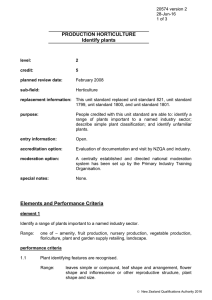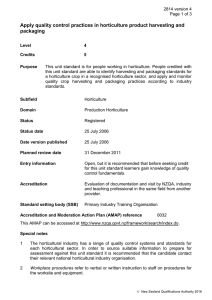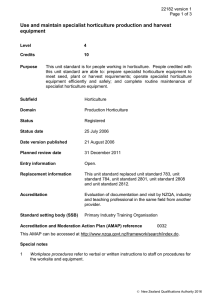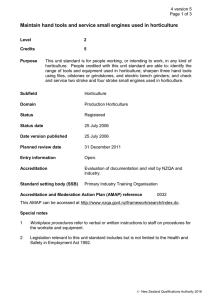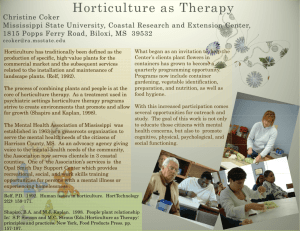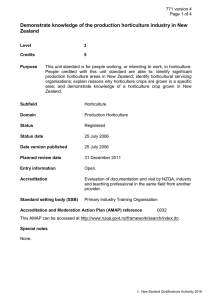Demonstrate knowledge of quality control systems in production horticulture
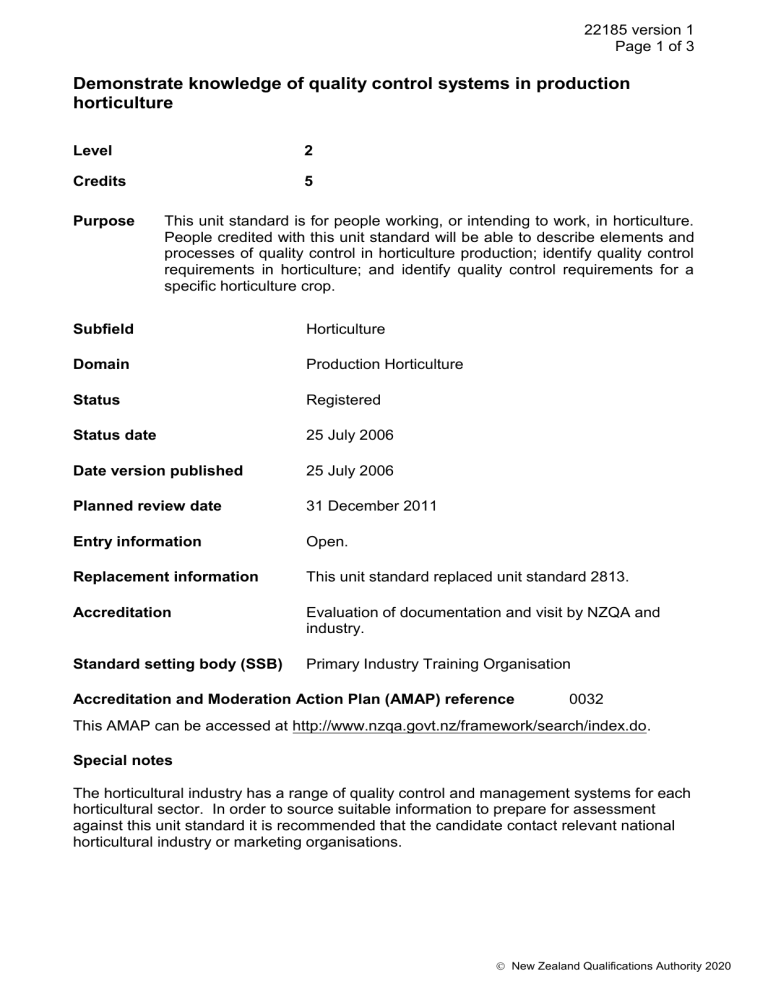
22185 version 1
Page 1 of 3
Demonstrate knowledge of quality control systems in production horticulture
Level 2
Credits 5
Purpose This unit standard is for people working, or intending to work, in horticulture.
People credited with this unit standard will be able to describe elements and processes of quality control in horticulture production; identify quality control requirements in horticulture; and identify quality control requirements for a specific horticulture crop.
Subfield Horticulture
Domain
Status
Status date
Date version published
Production Horticulture
Registered
25 July 2006
25 July 2006
Planned review date
Entry information
31 December 2011
Open.
Replacement information
Accreditation
This unit standard replaced unit standard 2813.
Evaluation of documentation and visit by NZQA and industry.
Standard setting body (SSB) Primary Industry Training Organisation
Accreditation and Moderation Action Plan (AMAP) reference 0032
This AMAP can be accessed at http://www.nzqa.govt.nz/framework/search/index.do.
Special notes
The horticultural industry has a range of quality control and management systems for each horticultural sector. In order to source suitable information to prepare for assessment against this unit standard it is recommended that the candidate contact relevant national horticultural industry or marketing organisations.
New Zealand Qualifications Authority 2020
22185 version 1
Page 2 of 3
Elements and performance criteria
Element 1
Describe elements and processes of quality control in horticulture production.
Performance criteria
1.1 Key elements required to establish quality control are identified.
Range elements may include but are not limited to – product quality, procedures to be adopted, levels of acceptable performance, monitoring of performance, improving performance.
1.2 Key processes required to implement quality control are identified.
Range processes may include but are not limited to
– setting the standards, training people involved, supervision/monitoring of performance, correction of problems and development of new regulations.
Element 2
Identify quality control requirements in horticulture.
Performance criteria
2.1 Factors, which determine quality of a horticulture crop, are identified.
Range factors may include but are not limited to
– growing media preparation, plant and seed selection, planting, plant management, harvesting and handling crop, storage and packaging.
2.2 Factors, which influence achievement of quality standards for each of the factors identified, are defined.
Range factors may include but are not limited to – standards set, timing, methods and materials used, care taken, supervision provided, training, skilled workers.
2.3 Standards, which determine horticulture quality requirements, are identified.
Range standards may include but are not limited to bodies, product market demand and supply, site standards, competition.
– industry controlling
New Zealand Qualifications Authority 2020
22185 version 1
Page 3 of 3
Element 3
Identify quality control requirements for a specific horticulture crop.
Performance criteria
3.1 Standards, which determine horticulture quality requirements for a specific crop, are identified.
3.2 Quality control processes are described, demonstrating how these standards are implemented for a specific crop.
Please note
Providers must be accredited by the Qualifications Authority, or an inter-institutional body with delegated authority for quality assurance, before they can report credits from assessment against unit standards or deliver courses of study leading to that assessment.
Industry Training Organisations must be accredited by the Qualifications Authority before they can register credits from assessment against unit standards.
Accredited providers and Industry Training Organisations assessing against unit standards must engage with the moderation system that applies to those standards.
Accreditation requirements and an outline of the moderation system that applies to this standard are outlined in the Accreditation and Moderation Action Plan (AMAP). The
AMAP also includes useful information about special requirements for organisations wishing to develop education and training programmes, such as minimum qualifications for tutors and assessors, and special resource requirements.
Comments on this unit standard
Please contact the Primary Industry Training Organisation via their website www.primaryito.ac.nz if you wish to suggest changes to the content of this unit standard.
New Zealand Qualifications Authority 2020
